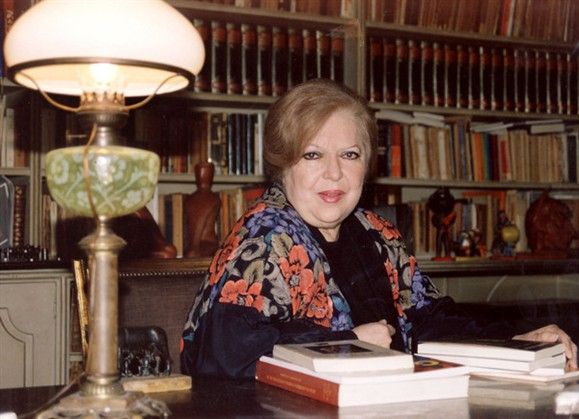Obras de referência da cultura portuguesa
"O ENCOBERTO"
de NATÁLIA CORREIA
Análise de Duarte Ivo Cruz
Tradução de Alexandra Leitão

Entre 1584 e 1598, a história regista o surgimento de quatro falsos D. Sebastião, que tentaram, com pouca verosimilhança e nenhuma sorte, fazer-se passar pelo Rei Desejado. Alimentaram o mito e foram objeto, pelo menos três deles, de tentativas de dramatização com resultados muito desiguais, no ponto de vista teatral. Essas peças estão quase todas tão esquecidas como os aventureiros que lhes deram o tema...
Com a exceção de "O Encoberto" (1969) de Natália Correia, texto oscilante entre um simbolismo barroco e algo próximo do teatro narrativo, mas de indiscutível força poética, não obstante a exuberância, violência, por vezes a tocar o blasfemo, da estrutura e da linguagem. Reconstitui, com total liberdade criativa, as aventuras, essas sim, amplamente documentadas, do calabrês Marco Tulio Catizone. Como dissemos, de nada lhe valeu a aventura.
Natália transforma Marco Tulio num ator de mísera expressão, integrado numa companhia ambulante não por acaso denominada "O Purgatório dos Comediantes". Marco Tulio usa em cena o nome de Bonamis, e tem como parceiros principais a sua amante Floriana e um coro de três “catadeiras” que conferem à peça a sua dimensão próxima do teatro épico, através de poemas e canções intercalares. O ator e o personagem alternam habilmente posições, que se projetam na conduta e na linguagem: oscilam entre a figura do Rei, que como tal se exprime, e a do comediante desgraçado, ao serviço de um público miserável que o não entende. E surgem, como comparsas da grande burla humana e politica, personagens históricas, como D. João de Portugal.
Bonamis desdobra-se assim entre os dois papéis existenciais, o do rei destronado e o do ator-aventureiro burlão. Até que ponto o desdobramento é sincero, o espectador ajuizará: sendo certo, tal como já dissemos, que a linguagem se transforma de acordo com a personagem que, alternadamente, Bonamis encarna.
Com uma técnica claramente brechteana, a peça abre com a canção de Floriana, denominada precisamente "O Romance da Moura Huria": estamos aqui em plena representação teatral, mas que indicia ou anuncia o embuste em que Marco Tulio se envolve:
"Andando a apanhar rosas / num rosal que meu pai tinha / vi os cativos cristãos / que de Alcácer Quibir vinham / No rosal que meu pai tinha / um espinho me picou: / era o olhar de um cativo / que logo me cativou. / Ai triste de mim coitada! / chorava e tinha razão / que em sujeição que doía / era Dom Sebastião / quem ao Xerife meu pai / de joelhos o servia."
Aqui, estamos no imaginário teatral. Mas a partir dele, Marco Tulio-ator transforma-se em Marco Tulio-Rei Desejado. E cai-se aí no mito e na profecia oculta: "Vejo vir o Encoberto / que há-de expulsar os tiranos (...) / é um muro a nossa fé / no Rei Dom Sebastião".
A peça desenvolve toda a intriga histórica, a partir das intervenções de Filipe II, Frei Diego, Cristóvão de Moura e uma comparsaria de nobres, banqueiros e povo. E a síntese política e simultaneamente, a mensagem ocultista do Encoberto, é D. João de Portugal que a transmite, assumindo-a em "recomendações" ao Bonamis ator e Rei:
"Que sobreviva a esperança no regresso do rei Encoberto. Se morreres como D. Sebastião, contigo se extingue toda a miragem da liberdade para este povo. Incrível e intemporal, esse rei de lenda é para os oprimidos a sensação de um grito por dar"...
"O ENCOBERTO" by NATÁLIA CORREIA
Between 1584 and 1598 history records the appearance of four false King Sebastians who tried, with very little verisimilitude and no luck, to pass themselves off as the Desired King. They fed the myth and at least three of them served as the plots in plays with very unequal results, theatrically speaking. These plays have been all but forgotten just like the adventurers that inspired them.
The exception is “O Encoberto” by Natália Correia, a text that oscillates between baroque symbolism and something similar to narrative theatre, although with undisputable poetic force, despite the exuberance, the violence bordering at times on blasphemy, the structure and the language. With total creative liberty it reconstitutes the amply documented adventures of the Calabrese Marco Tulio Catizone. As we have said, he gained nothing from the adventure.
Natália Correia makes Marco Tulio an actor with a pitiable expression, a member of a group of travelling actors not by chance called “The Purgatory of the Comedians”. On stage Marco Tulio goes by the name of Bonamis and his main partners are his lover Floriana and a chorus of three “female delousers” whose poems and songs lend the play a dimension close to epic theatre. The actor and the character skilfully alternate their positions, projected in the conduct and the language: they oscillate between the figure of the King, who speaks as one, and that of the poor comedian serving a poor audience who does not understand him. Partners in this major human and political burlesque are historic characters such as King D. João of Portugal or the Italian Alexandro.
Bonamis thus has two existential roles, that of dethroned king and of a cheating actor-adventurer. The spectator will judge how far the two roles are successful, although, as we have said the language changes according to the character played by Bonamis in turn.
With a clearly Brechtian technique the play opens with a song by Floriana, called “The Romance of Houria, the Moorish maid”. We are in full theatrical representation, hinting at or announcing the trickery in which Marco Tulio is involved:
“Whilst gathering roses in my father’s rose-garden, I saw the Christian captives who came from Alcazarquivir. In my father’s rose garden I was pricked by a thorn: it was the look of a captive who captivated me. Oh, woe is me! I cried and I was right to think that so subserviently that it hurt it was Dom Sebastião who served the Sheriff my father on his knees.”
This then is theatrical imagery. From there, Marco Tulio the actor becomes Marco Tulio the Desired King. And there we venture into myth and occult prophecy: “I see the Hidden One coming who will expel the tyrants. Our faith in King D. Sebastião is as a wall.”
The play unfolds the entire historic intrigue based on interventions by Philip II, Friar Diego, Cristóvão de Moura and assorted noblemen, bankers and people. The political synthesis and simultaneously the occultist message of the Hidden One is conveyed by King D. João of Portugal, taking it up in “recommendations” to Bonamis, actor and king:
“May the hope in the return of the Hidden King survive. If you die like D. Sebastião, with you dies the mirage of freedom of these people. Incredible and timeless, for oppressed people that legendary king is the feeling of a scream that is not uttered”.
projeto desenvolvido pelo Centro Nacional de Cultura

 Divulgue aqui os seus eventos
Divulgue aqui os seus eventos













